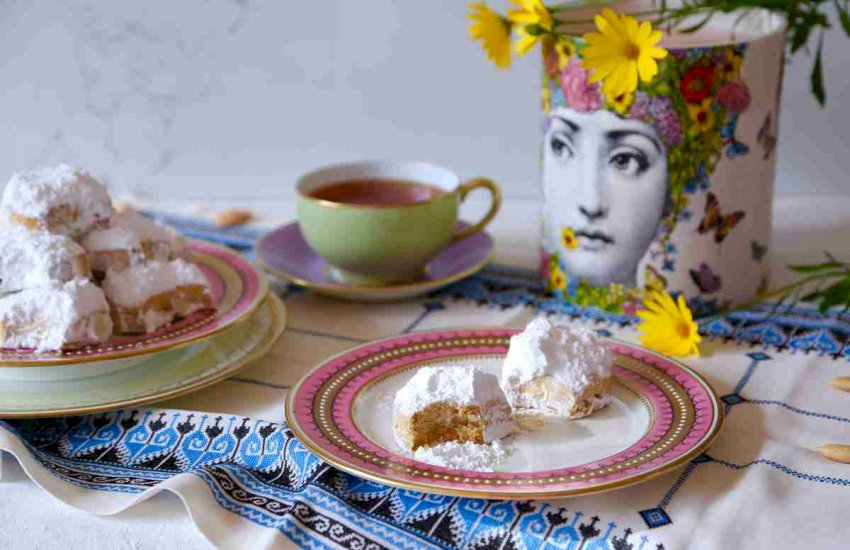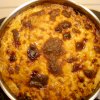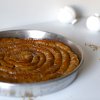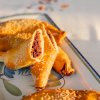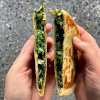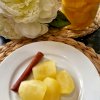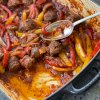Dimitra's Kourabiedes
Dimitra’s kourabiethes have the perfect balance of butteriness and crumbliness, and along with beautiful bursts of roasted almonds and a very generous coating of icing sugar, they will certainly satisfy your sweet tooth. They are usually made for Christmas and Easter as a treat to share with family and friends, but they are so good, that you’ll want to make them all year round!
Ingredients
50-60 g 50 – 60 pieces blanched almonds
250 g unsalted butter at room temperature
30 g pure icing sugar sifted
1 egg yolk
1 teaspoon vanilla extract
500 g white self-raising flour sifted
Additional 250g pure icing sugar sifted
Preparation
Preparing the blanched almonds
- Cut the blanched almonds into 3-4 pieces each, place them in a pan and dry-roast them in an oven preheated to 180°C fan-forced till they brown (approximately 10 minutes)
- Remove them from the oven and allow them to cool to room temperature before using them in the recipe
Preparing the kourabiethes
- Add the butter and 30g pure icing sugar to a stand-up mixer and beat until creamed
- Beat in the egg yolk and vanilla extract well
- Remove the mixing bowl from the stand
- Scrape down the sides of the mixing bowl and mix the butter mixture well
- Slowly add the flour and mix it through with each addition, until you have a dough with a dry, crumbly texture that can be formed into a kourabie, when you mould and press it together with your hands
- Add the roasted almonds halfway through the flour adding process
- When the dough is ready, take a handful and place it on your clean work surface
- Gently press down on it, until it forms a large even disc that is about 1.5cm high
- Using a drinking glass or a round cookie cutter, cut out a round kourabie
- Using the drinking glass or cookie cutter once more, cut out a small section at the edge of the kourabie, so that the kourabie resembles a large, round crescent
- Place the kourabie on a baking tray that has been greased with unsalted butter
- Add the small dough offcut back into the kourabie dough
- Repeat until all the dough has been shaped into kourabiethes (Note: the last kourabie will be round in shape and a different size to the remaining kourabiethes)
- Bake the kourabiethes in an oven preheated to 180°C fan-forced till they are a light, golden-brown colour (approximately 30-35 minutes)
- When the kourabiethes are taken out of the oven, immediately coat them with icing sugar
Coating the kourabiethes
- Place 250g of sifted pure icing sugar in a bowl
- Take a kourabie and sit it in the icing sugar
- With your fingers, pick up some icing sugar and sprinkle it on top of the kourabie
- Pat the icing sugar down gently
- Repeat, till you have a 1-1.5cm thick layer of icing sugar
- Repeat for all the kourabiethes
Serving the kourabiethes
- Once the kourabiethes have cooled, they can be enjoyed!
Key Points
Dimitra always blanches her own whole almonds before cutting and roasting them. She feels they taste fresher in the kourabie and believes this small extra step makes for a better final result. She says she can taste the difference.
The blanched almonds need to be prepared well ahead of time, to ensure they are cool when added to the kourabie dough, otherwise, the heat in the almonds will melt the butter in the dough and you won’t be able to form the kourabiethes.
It is important for the almonds to achieve a lovely golden-brown colour when they dry roast, so they can impart that wonderful roasted almond flavour to the kourabiethes. At the same time, it is important not to over-brown or burn the almonds, as this will add bitterness to the kourabiethes.
Depending on the ambient air temperature, the softness of the butter and the strength of the flour you use, you will need to adjust the quantity of flour you add each time, to achieve the right texture in the dough. In addition, if you prefer crumbly, drier kourabiethes you will use more flour. If you prefer softer, buttery kourabiethes, you will use less flour. It may take a few attempts to work out the dough consistency that is needed to achieve your preferred kourabie texture.
Add the flour very slowly and mix it well with each addition. It is easier to add a little flour if the dough is still soft and buttery than suddenly end up with a very dry dough, that can’t be saved.
Although the recipe calls for 500g of flour, usually less is added (approximately 450g)
Depending on your kourabie size preference, you can use a larger or smaller cookie cutter.
The kourabiethes must be baked till they are a light-medium, golden-brown colour, otherwise, they will be undercooked and they will stick to the roof of your mouth when you eat them.
The kourabiethes need to be hot when you coat them with the icing sugar, so the base layer of the sugar sticks to the kourabie and keeps the rest of the icing sugar in place. Have your icing sugar sifted and ready, so you can coat the kourabiethes with the icing sugar when they come straight out of the oven. If you try to coat cooled kourabiethes, the icing sugar will just slide off.
Always use pure icing sugar when coating the kourabiethes, otherwise, the butter will be drawn out by the icing sugar and will spoil the look of the kourabiethes
DO NOT INHALE when taking a bite of the kourabie.

